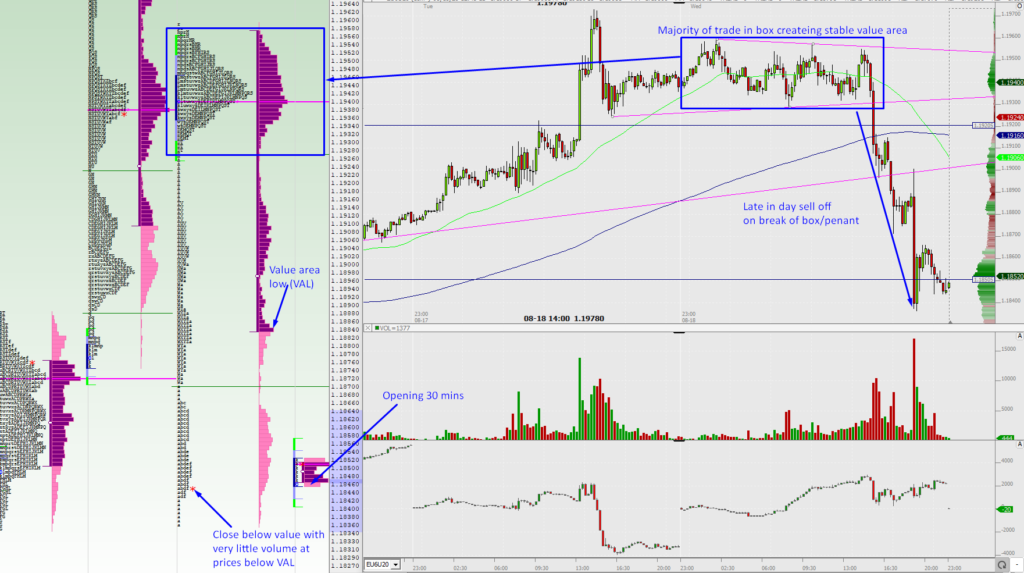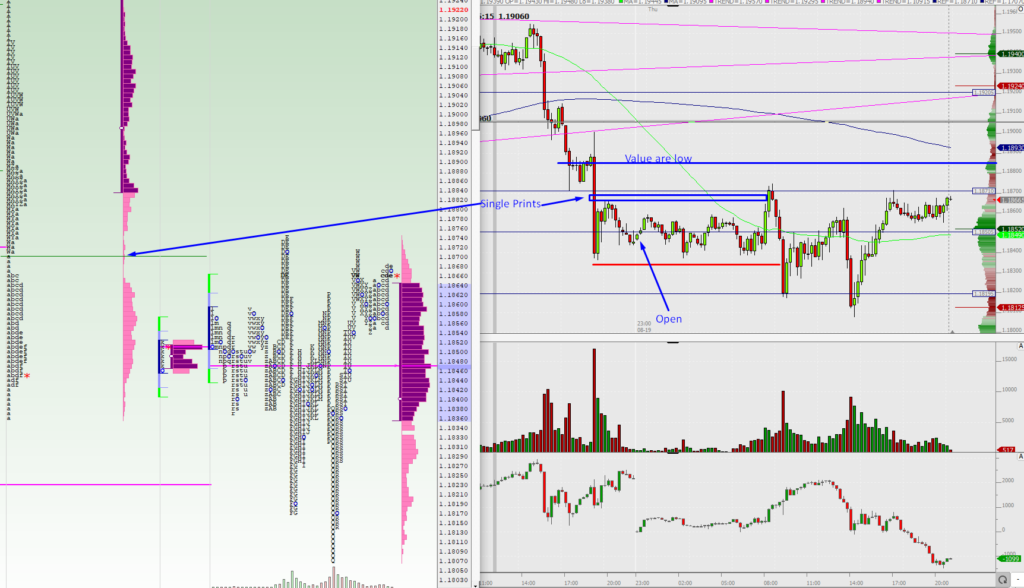Whilst a market profile is more typically used to better understand context and timing of trades, it also provides some very specific trades that don’t require the use of a candlestick charts to find an appropriate access point. The Caught in the Hole Trade is a case in point – what the profile shows you indicates the trade to take the following day.
What Is The Market Profile Showing You?
Market profile theory suggests that a move is unsustainable if value (where the majority of time/volume has traded) has not moved with a price change. A caught in the hole opportunity occurs when a market moves a long way from value without putting in any significant amount of volume. This can be seen in the chart of EURUSD futures below. The move lower has been created by late in the day sellers after a day where value (purple highlighted bars) has been stable at higher prices. These sellers have effectively sold too low; without additional selling coming in the next day to move value lower they will be caught in hole, knowing they have a position that doesn’t match up with where the market as a whole deems ‘good’ value to be.

What Is The Trading Strategy?
A reversal trading strategy to play against the sellers and capitalise on them exiting positions causing a move back towards yesterday’s value area can be executed from the open, with your risk being a break of yesterday’s low. A couple of considerations do need to be taken into account:
- Where is the market opening? Because the execution of this trade can be at the open, ideally the open is close to the low of the day – this will give a limited risk (break of the low) and enhanced reward (move back to value area low) furthermore, the sellers who pushed the market down won’t get out on the opening price if it is near the low as they will likely still be on side so can hope for a continuation. When/if the continuation doesn’t materialise they will scramble for the exit creating the reversal. Conversely, in the event that the open is close to the value area low then many of the sellers will exit in the opening auction, thus reducing the number of potential buyers but also the reward on the trade, particularly when weighed against the risk of breaking the low.
- Are there any hurdles along the route back to value? These will need to be factored in to your trading strategy. In the example above, a set of single prints are visible between 1.1867-1.1870, the accompanying low volume at price indicates a point where sellers gained control and can be assumed to come back in at those prices. So, part of your trade strategy has to take account of this and can give an opportunity to scale out of position unless clear buying is seen through the single prints.
- Caught in Hole Trade with T-Note correlation
- How to Trade a Caught in The Hole
- Caught in the Hole in Dax, S&P500 and Bund
How Did The EURUSD Futures Trade Strategy Play Out?
If you played the caught in the hole trade strategy above what would have been the result. Buying from the open gave a risk of 12 ticks and reaching the single prints gave a reward of 24. The trade did take 9 and a half hours to play out. The main directional play could well have been taken from the point when UK traders come in at 8am BST: The clear pick up in volume gave a strong indication of buying and whilst the move from overnight highs to single prints was smaller (10 ticks 1.1860-70) the order flow gives greater conviction and this can offer an alternative trading strategy. Of course the key part of this trade was recongising when to exit – the failure to continue past 1.1870 was the clue to exit and would prevent taking a loss on a break of the low.

Remember every trade can have multiple access points and whilst the Caught in the Hole trade strategy can have a very rigid entry, stop and exit their are alternative ways to execute the trade. These nuanced method of entry and trade management are explored extensively in our 8 week Trading Course. To learn to trade with the market profile, you might consider checking our market profile trading course or viewing our full range of Trader Training courses. which can attended live on our London Trading Floor or virtually from home. We offer the most comprehensive training programmes in the proprietary trading industry which are based upon years of successful in-house skills development.
Richard




